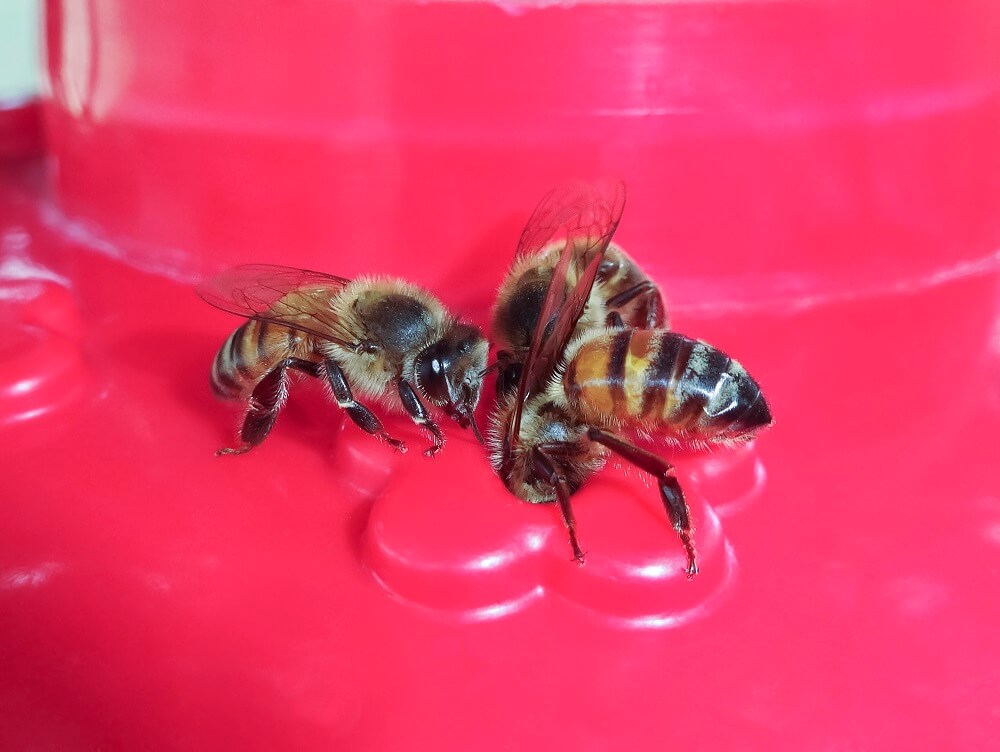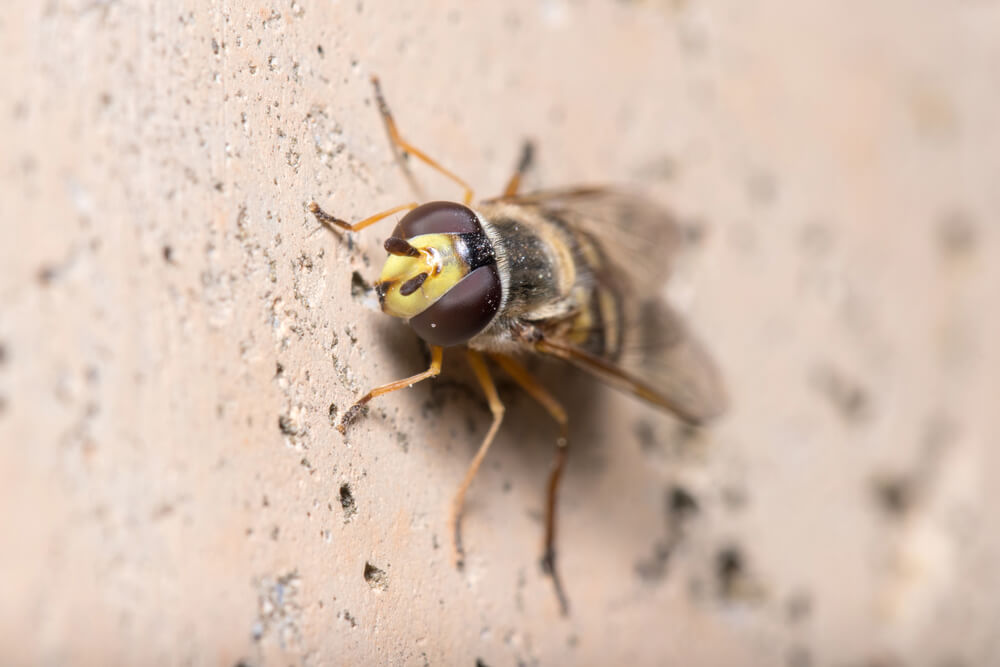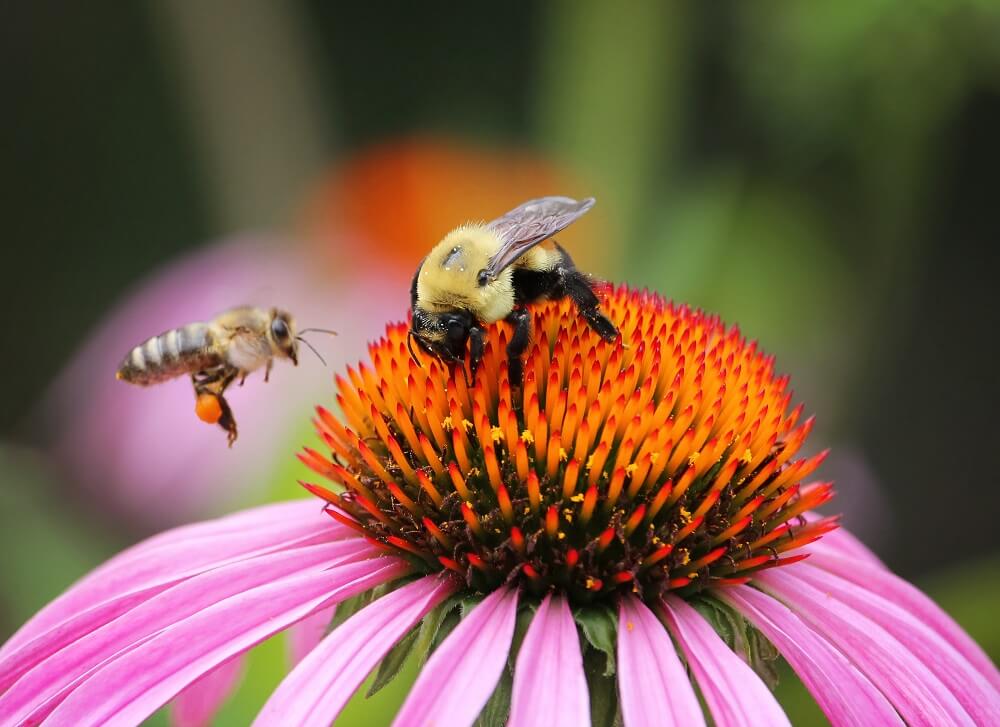Table of Contents:
How to Keep Bees Away From Hummingbird Feeders
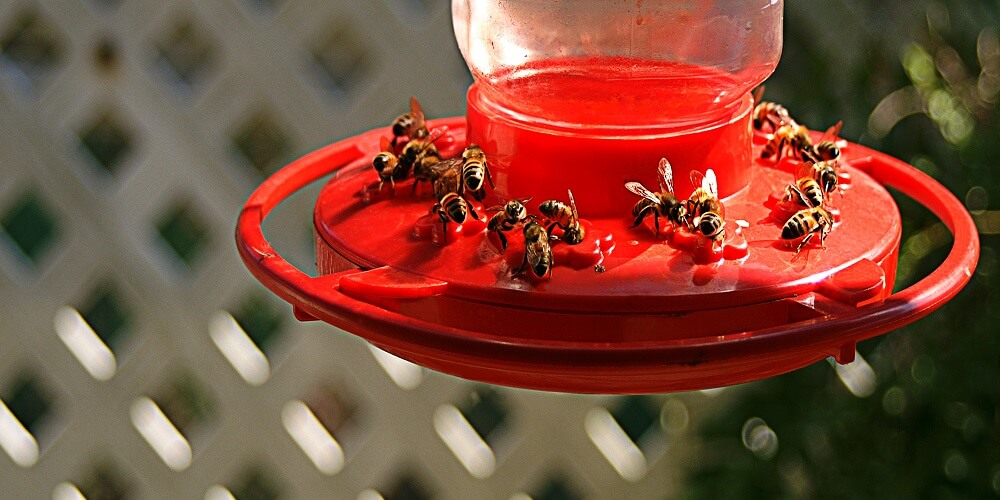
1. Use Bee Guards
Bee guards are covers that go over the port of your hummingbird feeders. They keep the bees out while allowing the hummingbirds in.
These bee guards are my favorite because they’re pretty universal in size, so they’ll fit many types of feeders.
Now keep in mind:
At first, the bees will continue trying to drink from your hummingbird feeders. But not long after, they’ll take the hint and leave once they realize they can’t access the sugar water.
Another good option for bee guards is the ones from Perky Pet:
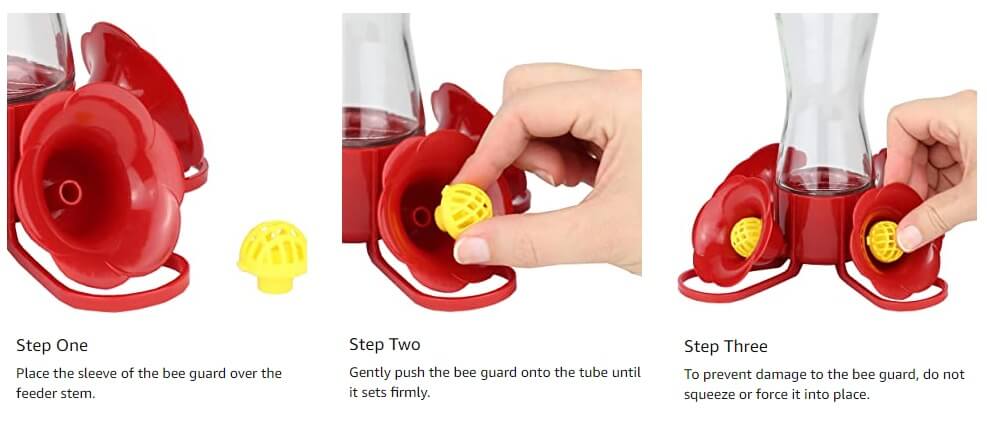
The bees can’t reach the sugar water with these bee guards because their tongues aren’t long enough.
Make sure to check the sizing chart when buying Perky Pet’s bee guards. They have different sizes for different feeders. On the other hand, Aspect’s bee guards are pretty universal in size.
Related: Do Carpenter Bees Sting?
2. Use Bee-Proof Feeders
When it comes to bees, not all feeders are created equally.
There are two standard hummingbird feeder designs:
- Bottle design
- Dish design
Here’s an example:
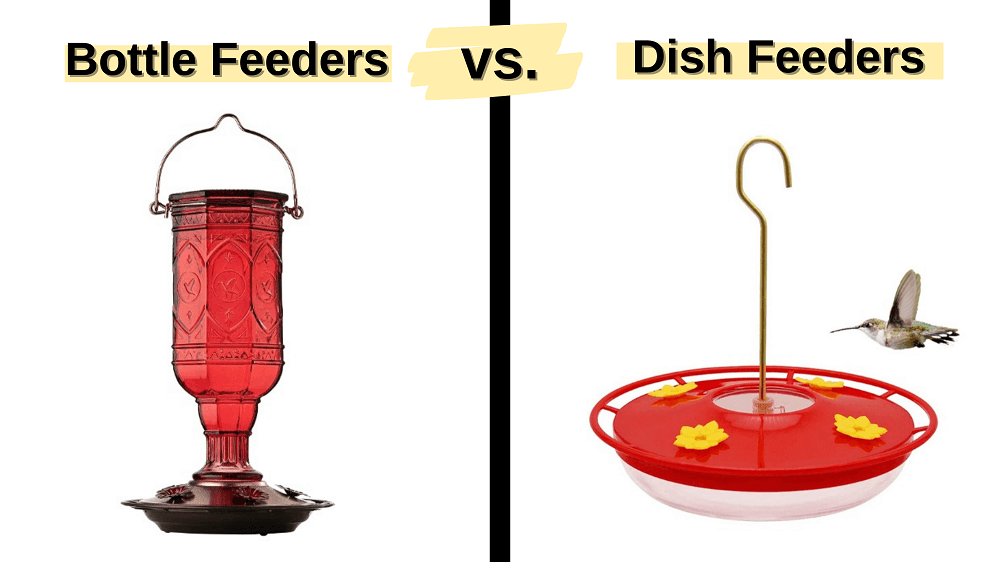
The dish design is the way to go if you’re trying to keep bees away from your hummingbird feeders.
Why?
Because with dish feeders, the sugar water sits below the feeding ports in a dish. As the hummingbirds drink the sugar water, the distance between the sugar water and the port increases.
So what does this mean for bees?
They can’t reach the sugar water because their tongues simply aren’t long enough. In contrast, hummingbirds have no trouble sipping out of the dish feeders because of their long tongues and beaks.
But on the other hand?
Bottle-style feeders make it easy for bees to drink because there’s no gap between the feeding ports and the sugar water. Bottle feeders also leak more than dish feeders, leaving more room for attracting bees.
Related: Do Bumble Bees Sting?
3. Grow a Pollinator Garden

There’s no other way to tell you this.
But the reason bees are coming to your feeders isn’t because it’s convenient. It’s because nectar sources are low in your area and the bees are desperate for food.
To put it simply:
Bees prefer drinking nectar instead of sugar water.
Not only does nectar taste better to bees, but it has a lot of nutritional value as well. In fact, bees won’t even touch your hummingbird feeders when plenty of nectar sources are available.
So let me briefly bust two myths:
- “Bees drink from hummingbird feeders because they’re lazy.” Not true. People can call bees many different things, but lazy isn’t one of them. These wonderful little creatures work 12+ hours per day for their hive. They never take days off.
- “Bees drink from hummingbird feeders because it’s convenient.” Not true. Bees drink from hummingbird feeders because there aren’t enough flowers available. They resort to sugar water as a last option to help keep their hive alive. It has nothing to do with convenience because if bees had their way, they’d be sipping nectar from flowers instead.
Chances are, you’ve read these myths at some point. Don’t fall for them.
At Learn Bees, we care about all pollinators, including bees, hummingbirds, butterflies, beetles, and more.
And I know you do too.
So what can you do to help?
Plant a pollinator-friendly garden with flowers that are drought resistant during the hot summer months.
Pick flowers that bloom at various times during the summer. For example, choose some that bloom in June, some in July, and some in August.
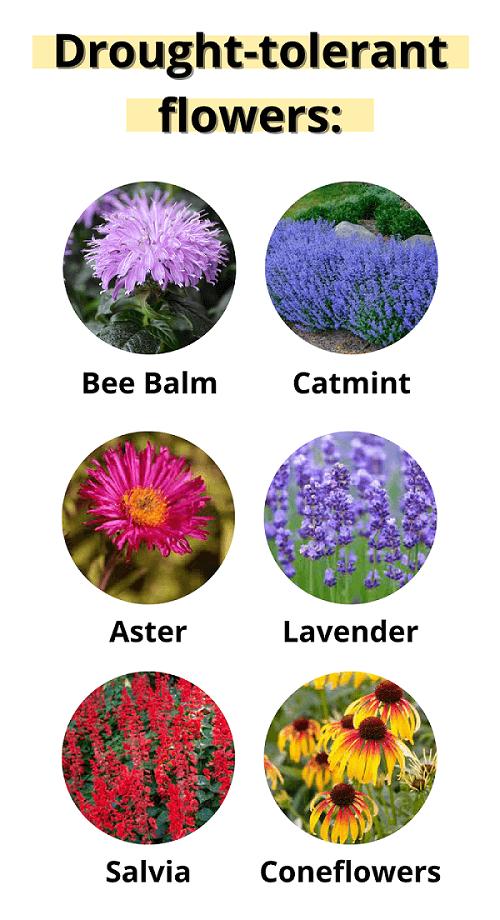
Here are the links for drought-tolerant flowers:
4. Feed the Bees

Many beekeepers supplement their honeybee’s diet with sugar water when flower sources aren’t available.
So how do you do it?
Well, if bees are coming to your hummingbird feeders, you can leave them alone and allow them to drink. Then you can buy these bee-proof feeders specifically for your hummingbirds.
That way, both the hummingbirds and bees get to drink from their own feeders.
Win-win.
But here’s the thing:
The sugar water recipe for bees is different than it is for hummingbirds. For bees, it’s a 1:1 mixture of white sugar to water (during the spring and summer).
During the fall, the sugar water mixture for bees is 2:1 – two parts sugar to one part water. The bees need extra sugar during the fall to prepare for winter.
Also, here’s an extra tip:
Add a few drops of plant-based blue food coloring to the sugar water. The bees coming to your bee feeders may belong to local beekeepers. So adding blue food coloring will turn their honey blue.

Why is this important?
Because beekeepers only harvest honey that comes from nectar. They want the authentic stuff. So this allows your local beekeepers to tell the difference between real honey and sugar water – because bees will store both inside the honeycomb.
(You can use other colors besides blue food coloring – such as green or red. The only color I don’t recommend is yellow because most honey is naturally golden).
And last but not least:
Clean both your bird and bee feeders regularly. Sometimes feeders can become a hotspot for mold or infections.
Soak them in a sink filled with 10 cups of hot water to one cup of bleach. Then rinse the feeders with hot water and wash them with soap before giving them one final good rinse.
And then?
Dry them thoroughly and put them back outside. Do this every time you refill your feeders – or more often if you’re diligent – and you’ll reduce the risk of infection and mold.
Related: Do Honey Bees Sting?
5. Identify and Fix Leakage

It’s not uncommon for hummingbird feeders to leak and drip sugar water. Bottle-style feeders are more likely to leak than dish feeders, especially if they’re plastic.
Older feeders that have experienced years of sun damage are also at risk of cracking and leaking.
The only problem?
Leaky feeders are bee and ant magnets.
So if you have a leaky feeder, first check that the feeding ports and reservoir are properly aligned. Sometimes misalignment can create gaps that lead to drippage.
What about if your feeders are cracked?
The best option is to replace them with a high-quality hummingbird feeder that can withstand the sun, wind, and thunderstorms.
The next best choice is to try covering the crack with a sealant like flex tape.
Also, make sure you clean the feeder each time you refill it to remove any sticky residue on the feeder base. If not, bees will become drawn to your feeders like a magnet.
And finally?
Don’t overfill your hummingbird feeders to the point of leakage. It’s better to refill them weekly with smaller amounts of sugar water than to refill them with large amounts every few weeks.
Related: How Long Do Bees Live?
Are Hummingbirds Afraid of Bees?

Nope!
Don’t worry. Pollinators like hummingbirds, bees, and butterflies have coexisted peacefully for thousands of years. They won’t attack each other.
And the good news is that having a few bees at your feeders won’t prevent your hummers from coming. But, if the bees start coming in large numbers, then the hummingbirds might get crowded out.
So your best bet?
Create a pollinator-friendly garden that serves hummingbirds, bees, butterflies, and more. Plant a variety of drought-tolerant flowers that bloom throughout the summer.
Also, hang feeders for both hummingbirds and bees. Use bee-proof feeders for the hummers and regular feeders for bees. Put them far enough apart, so bees and hummers have their own space.
Related: Honeybees vs. Bumblebees: How Do They Compare?
2 Things to Avoid When Detering Bees

Here’s the thing:
Learning how to keep bees away from hummingbird feeders is simple. Use bee guards, bee-proof feeders, and/or plant a bee-friendly garden.
But when it comes to protecting our lovely pollinators, there are two things you shouldn’t use:
Insecticides
Even a small amount of chemicals near hummingbird or bee feeders can be devastating to their tiny bodies.
The best approach is a non-toxic one. This means be cautious of using chemicals, including weed killers, ant killers, wasp killers, and even fertilizers. It’s best to do your research before using these things in your yard.
Some might harm pollinators while others might not. You just never know until you do a google search first.
Also, be aware that “natural” doesn’t always mean safe. For example, vinegar is fatal to bees on contact, but it’s commonly used in yards across the country. No bueno.
Related: Do Bees Have Lungs?
Petroleum Jelly
Some articles recommend using petroleum jelly as a method for how to keep bees away from hummingbird feeders. This home remedy involves rubbing the jelly around the feeding ports to deter ants and other insects.
But many bird experts don’t recommend it.
Why? Because it can stick to the hummingbird’s feathers, making it difficult for them to fly and clean themselves. Birds can also swallow the petroleum jelly, making them sick.
Related: Do Sweat Bees Sting?
FAQs on “How to Keep Bees Away From Hummingbird Feeders”
- Does peppermint oil keep bees away from hummingbird feeders?
- What is a good repellent for bees?
- Why are honey bees swarming my hummingbird feeder?
- What’s the best bee-proof hummingbird feeder on Amazon?
- What is a bee guard for a hummingbird feeder?
Does peppermint oil keep bees away from hummingbird feeders?
Yes, but you shouldn’t use peppermint oil alongside your hummingbird feeders.
Here’s why:
Despite the fact that concentrated peppermint oil is a bee repellent, it’s not healthy for birds at all. So just don’t risk it.
—> Go back to the FAQs on “How to Keep Bees Away From Hummingbird Feeders”
More to Explore:
What is a good repellent for bees?
This is a common question we get, along with numerous other questions such as:
Does vinegar deter bees? Does cinnamon repel bees? What is a natural way to repel bees? How do I keep bees away from my bird feeder? Can I keep unwanted bees away from hummingbird feeder? How to keep sweat bees away from hummingbird feeders? How to keep bees away from bird feeders?
The answer is to use bee guards on your feeders. Bee guards do exactly what you’d expect – they create a guard that prevents the bee from reaching the sugar water. Bees can’t reach their tongues past the guards because their tongues aren’t long enough.
On the other hand, hummingbirds can easily use a feeder even with a bee guard placed on it. Their long beaks and tongue make the job easy.
Another way to learn how to keep bees away from hummingbird feeders is with dish-style feeders. In dish feeders, the sugar water sits below the feeding ports in a dish. This means the distance between the sugar water and the port is greater, so the bees can’t reach the sugar water with their tongues.
Once the bees realize this, they’ll leave your dish feeders alone.
And finally?
Planting a pollinator-friendly garden will keep bees away from your hummingbird feeders.
—> Go back to the FAQs on “How to Keep Bees Away From Hummingbird Feeders”
More to Explore:
Why are honey bees swarming my hummingbird feeder?
People often ask, “Do bees drink from hummingbird feeders?” and “Why are there swarms of bees on hummingbird feeders?”
Bees are attracted to sugar water when there aren’t enough flowers available to get nectar from. This nectar shortage is called a nectar dearth, and it can happen during droughts or hot and humid summer months.
The honeybees flock to hummingbird feeders as a last resort for food. But trust me, they don’t want to. They only do it because they have to. If they had more nectar sources nearby, then they wouldn’t even touch your sugar water.
—> Go back to the FAQs on “How to Keep Bees Away From Hummingbird Feeders”
More to Explore:
What’s the best bee-proof hummingbird feeder on Amazon?
These are the ones I recommend. They’re affordable, and they do the trick if you’re looking for the best hummingbird feeder to keep bees away.
—> Go back to the FAQs on “How to Keep Bees Away From Hummingbird Feeders”
More to Explore:
- Ground Bees: Are They Harmful to Your Yard?
- Why Do Vulture Bees Eat Rotting Flesh?
- What Do Bumble Bees Eat?
What is a bee guard for a hummingbird feeder?
A bee guard does exactly what it sounds. It guards your hummingbird feeders against bees by preventing the bees from accessing the sugar water.
You press bee guards onto the feeder ports, and it creates more space between the port and the sugar water. Bees don’t have long enough tongues to compensate for the extra space, so they can’t sip on the sugar water.
I’ve heard of people making homemade bee guards for hummingbird feeders, though I personally just buy them online.
Sometimes people ask me, “Do you recommend any red bee guards for hummingbird feeders?”
I don’t. Most of the bee guards I’ve seen are either transparent or yellow. I haven’t seen many red ones.
—> Go back to the FAQs on “How to Keep Bees Away From Hummingbird Feeders”
More to Explore:
